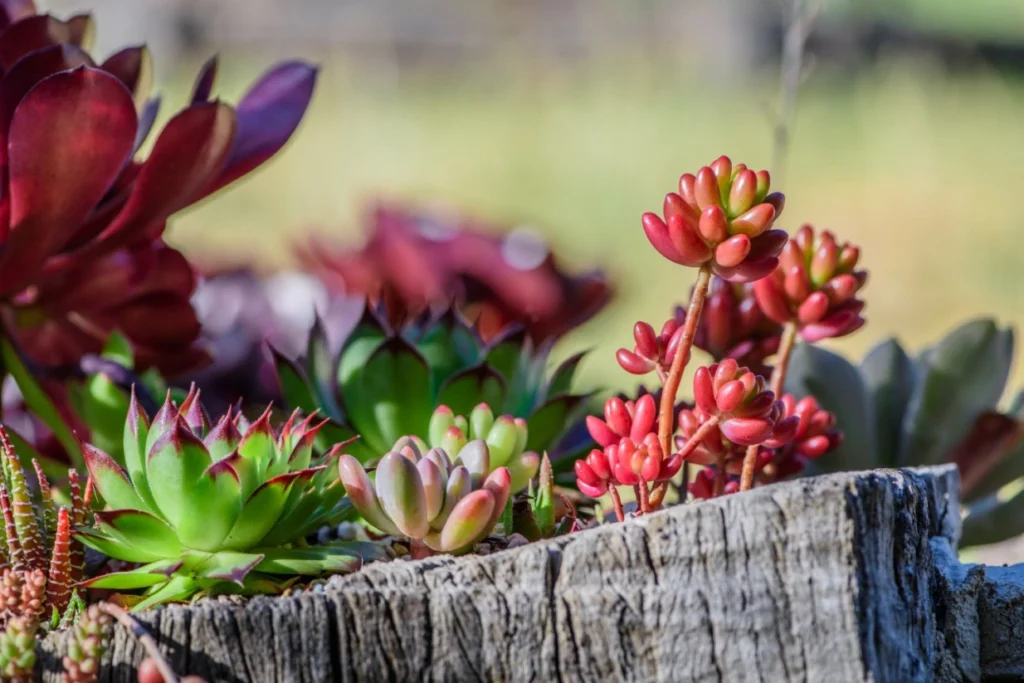Creating a garden of succulents brings beauty, texture, and easy-to-maintain greenery into any outdoor or indoor space. Succulents are resilient, requiring minimal care while offering a diverse range of colors, shapes, and sizes. Whether designing a small container arrangement or transforming a backyard into a desert oasis, a well-planned succulent garden provides year-round visual interest.
Choosing the Right Succulents for Your Garden
Selecting the right succulents is the foundation of a thriving garden. These plants come in an array of varieties, each with unique care requirements and visual appeal.
Popular Succulent Varieties
- Echeveria – Known for its symmetrical rosette shape and pastel hues, this variety thrives in full sun and requires little water.
- Sedum – A hardy ground cover option, sedum grows well in outdoor gardens, spreading over rocks and surfaces.
- Aloe Vera – Functioning as both an ornamental and medicinal plant, it requires bright light and occasional watering.
- Hens and Chicks (Sempervivum) – These small-growing rosettes multiply readily, making them a great choice for borders and rock gardens.
- Crassula (Jade plant) – A popular indoor plant, jade requires minimal care while offering a lush, thick-leaved appearance.
Certain succulents suit indoor spaces better than others. For limited areas, consider tall indoor plants for small spaces, which complement succulent arrangements beautifully.
Preparing the Soil and Location
Soil quality and location play a crucial role in maintaining a healthy garden of succulents. These plants require well-draining soil to prevent root rot.
Ideal Soil Composition
Succulents thrive in sandy, gritty soil that promotes drainage. Instead of traditional garden soil, use:
- Cactus Mix: A pre-made option that offers excellent drainage.
- DIY Blend: Combine two parts sand, one part potting soil, and one part perlite or pumice for improved aeration.
Choosing the Perfect Garden Spot
Most succulents prefer bright, indirect sunlight or full sun, depending on the variety. For outdoor gardens, select:
- A spot with at least six hours of sunlight daily.
- An area free from excessive moisture or standing water.
- Raised garden beds to improve drainage.
If planting in containers, be sure they have drainage holes, allowing moisture to escape and preventing root rot.
Designing and Arranging a Succulent Garden
Once the location and soil are set, designing the layout enhances the visual appeal. Thoughtful planning ensures the garden remains structured and aesthetically pleasing.
Layering and Grouping
Grouping succulents by height and texture creates depth in the garden. Consider:
- Tall Succulents: Place at the back (Aloe Vera, Agave).
- Medium-Sized Plants: Position in the center for continuity.
- Trailing Varieties: Such as Burro’s Tail cascading from containers or rock edges.
Incorporating Decorative Elements
Succulents complement decorative elements such as:
- Pebbles and Stones: Creating a natural, drought-friendly landscape.
- Driftwood or Logs: Offering contrast between organic and structured elements.
- Pots and Raised Beds: Ideal for small spaces or patios, especially useful in locations with cold winters.
For those wanting to include climbing flora alongside succulents, check out options like flowering climbing vines for arbors.
Caring for a Garden of Succulents
Although low-maintenance, succulents require specific care to thrive.
Watering Schedule
Overwatering remains the most common mistake when caring for these plants. A suitable watering guideline includes:
- Water deeply but infrequently – Every 10-14 days during warmer months.
- Reduce watering in winter – In dormancy, some need watering as little as once a month.
- Check Soil Moisture – If the top two inches of soil are dry, it is time to water.
Sunlight and Temperature Considerations
- Outdoor succulents require ample sunlight but may need shade during peak afternoon heat.
- Indoor succulents thrive near south or east-facing windows with moderate light exposure.
- Protect plants from frost if temperatures drop below 40°F by moving pots indoors or covering garden-planted varieties.
Proper seasonal care helps maintain a vibrant and lasting display of succulents.
Propagation Methods to Expand the Garden
One of the most exciting aspects of a garden of succulents is how easily these plants propagate. With minimal effort, a collection can expand significantly.
Leaf and Stem Cuttings
- Gently twist off a healthy leaf, let it dry for a few days, then place it on well-draining soil.
- For stem cuttings, snip a section of the plant, allow it to callous, then plant it in a new pot.
- Water sparingly as new roots develop.
Offsets and Division
Many succulents, such as Hens and Chicks, produce offsets (baby plants). Simply separate these and replant in a different location.
Seed Propagation
Growing succulents from seeds requires more patience. Scatter seeds over a well-draining mix, lightly mist them, and keep them in indirect light until they sprout.
Dealing with Common Issues
Despite their resilience, succulents are susceptible to a few common problems. Knowing how to address these issues helps maintain a healthy garden.
Overwatering and Root Rot
Signs of overwatering include yellowing leaves, mushy stems, and fungal growth. Prevent this by:
- Using well-draining soil and pots with drainage holes.
- Watering only when the soil is completely dry.
Pests and Diseases
- Mealybugs: Tiny white pests that cluster along stems and leaves. Treat with rubbing alcohol or insecticidal soap.
- Fungal Infections: Caused by excess moisture. Ensure adequate air circulation and avoid overhead watering.
If looking to add other elegant yet hardy species to the garden, consider licorice plant tips for gardeners for a unique combination with succulents.
Seasonal Maintenance and Winter Care
As seasonal changes occur, adjustments in care keep succulents in peak condition.
- Spring and Summer: Ideal for repotting, fertilizing, and propagation.
- Fall: Gradually reduce watering to prepare for dormancy.
- Winter: Protect delicate species from frost by moving potted plants indoors or using garden covers.
Some drought-tolerant plants continue blooming in cooler months. For an appealing winter garden, review cyclamen care tips for beautiful blooms.
Final Thoughts
A well-planned garden of succulents offers a stunning, low-maintenance addition to any home. With the right selection, proper soil, and a mindful watering routine, these hardy plants thrive in various environments. Whether creating a small patio display or an expansive outdoor landscape, succulents provide lasting beauty and functionality with minimal upkeep. Incorporating decorative elements, propagating new plants, and managing seasonal care ensures a dynamic and thriving succulent collection for years to come.



